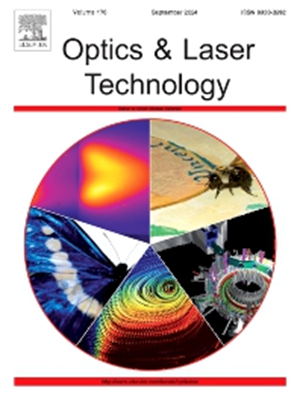Multi-focus beams with adjustable three-dimensional morphing spatial structure
IF 5
2区 物理与天体物理
Q1 OPTICS
引用次数: 0
Abstract
The beams with axial multiple focusing characteristic have been proven highly valuable in contemporary optics. We propose a new multifocal three-dimensional morphing (M3DM) beam featuring adjustable three-dimensional(3D) morphing spatial structure. By modulating the phase spectrum of a circular Airy beam via a chirped phase and a twisted phase, the circular Airy beam is transformed into a M3DM beam with four focal points. Moreover, the continuous three-dimensional enclosed dark space between two focal points in the middle presents the bottle beam characteristics. The 3D enclosed bottle space and even the focus points exhibit diverse structures by tuning the parameters of the modulated phase. From the energy flow analysis, it is observed that the gradient of energy flow varies with the beam structures. Employing the spatial multiplexing method, an array of M3DM beams is generated, capable of producing four times the number of focal points in 3D space. Furthermore, the dimension and focal position of each M3DM beam element can be independently adjusted with a high degree of freedom. Consequently, the proposed beam with its unique multifocal and self-rotational properties demonstrates promising applications in multiparticle trapping in 3D orientation, bioscience, optical communication, and multiplanar imaging.
具有可调三维变形空间结构的多聚焦光束
具有轴向多重聚焦特性的光束在当代光学中具有很高的应用价值。我们提出了一种新的多焦点三维变形(M3DM)光束,具有可调节的三维变形空间结构。通过啁啾相位和扭曲相位调制圆形Airy波束的相位谱,将圆形Airy波束转换成具有四个焦点的M3DM波束。中间两个焦点之间的连续三维封闭暗空间呈现出瓶束特征。通过调整调制相位的参数,三维封闭的瓶空间甚至焦点都呈现出不同的结构。从能量流分析中可以看出,能量流梯度随梁的结构而变化。采用空间复用方法,生成M3DM波束阵列,能够在3D空间中产生四倍数量的焦点。此外,每个M3DM波束单元的尺寸和焦点位置都可以高度自由地独立调整。因此,所提出的光束具有独特的多焦点和自旋转特性,在三维定向、生物科学、光通信和多平面成像的多粒子捕获方面具有广阔的应用前景。
本文章由计算机程序翻译,如有差异,请以英文原文为准。
求助全文
约1分钟内获得全文
求助全文
来源期刊
CiteScore
8.50
自引率
10.00%
发文量
1060
审稿时长
3.4 months
期刊介绍:
Optics & Laser Technology aims to provide a vehicle for the publication of a broad range of high quality research and review papers in those fields of scientific and engineering research appertaining to the development and application of the technology of optics and lasers. Papers describing original work in these areas are submitted to rigorous refereeing prior to acceptance for publication.
The scope of Optics & Laser Technology encompasses, but is not restricted to, the following areas:
•development in all types of lasers
•developments in optoelectronic devices and photonics
•developments in new photonics and optical concepts
•developments in conventional optics, optical instruments and components
•techniques of optical metrology, including interferometry and optical fibre sensors
•LIDAR and other non-contact optical measurement techniques, including optical methods in heat and fluid flow
•applications of lasers to materials processing, optical NDT display (including holography) and optical communication
•research and development in the field of laser safety including studies of hazards resulting from the applications of lasers (laser safety, hazards of laser fume)
•developments in optical computing and optical information processing
•developments in new optical materials
•developments in new optical characterization methods and techniques
•developments in quantum optics
•developments in light assisted micro and nanofabrication methods and techniques
•developments in nanophotonics and biophotonics
•developments in imaging processing and systems

 求助内容:
求助内容: 应助结果提醒方式:
应助结果提醒方式:


